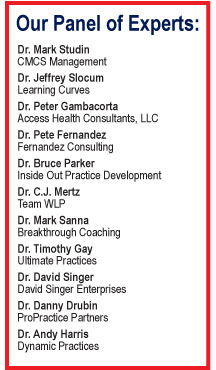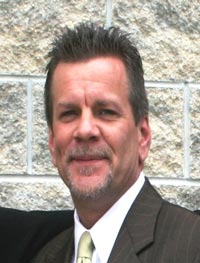Many of the profession’s leading practice coaches answer questions about the most common problems chiropractors face in their practices.


Practice Smarts from the Pro’s:
As we wrap up the end of 2008 and prepare for 2009, we’ve asked eleven of the profession’s leading practice coaches to answer what they feel are the most important questions to help you advance your practice. From focusing on who you are as a doctor to over-all advice to the entire profession, these experts have the answers to help guide you through the rest of this year and beyond.

 “The first step toward absolute victory in the success of your office is creating an infrastructure that works.”— Dr. Mark Studin, CMCS Management
“The first step toward absolute victory in the success of your office is creating an infrastructure that works.”— Dr. Mark Studin, CMCS Management
Q: Who do you work for?
A. The answer is, usually, our staff, as most doctors are not experienced in business policies and procedures. Therefore, it is much easier to abdicate the creation and implementation of those procedures to those we hire.
Many of you will also change procedures with each new staff member under the banner of, “It will work better because the new staff member says so.”The truth is, most offices have such little or no infrastructure (business systems) and this is the single reason for the “Roller Coaster” weeks and months in business. One week is great and the next, unpredictably, is horrible, where you can’t meet payroll or rent. I know, the problem is the insurance industry, the staff, the patients, the accountant and the dog. Did I miss anyone?
The truth is, every week can be very predictable.
The problem is you! A doctor is also a business person and, as the CEO of your business, you need to lead with an infrastructure that is reproducible (just like McDonald’s or IBM) and tested. Your staff has no leeway in changing your systems and they must answer to you, not the other way around.
The first step toward absolute victory in the success of your office is creating an infrastructure that works. Secondly, take absolute control by delegating and not abdicating every facet of your practice. Remember, it’s your name on the shingle out front!
For more information, call 1-631-786-4253 or visit www.CMCSmanagement.com.

 “When your actions in practice are supported by your values and guided by a clear vision, you will stay on purpose.”—Dr. Jeffrey Slocum, Learning Curves
“When your actions in practice are supported by your values and guided by a clear vision, you will stay on purpose.”—Dr. Jeffrey Slocum, Learning Curves
Q: Why is it that so many chiropractors have a hard time with burnout and frustration in practice?
A. Chiropractors are a very unique group of individuals that are, at the core, very compassionate and altruistic, which, in a service model, makes us very good care givers. On the other hand, we have, as a profession, a general lack of training or education in entrepeneurialship or business acumen, which, in a business model, makes us very uncertain and insecure. What this creates is a driven, ambitious, and optimistic care giver who lacks confidence, clarity, and certainty in business. The answer is to build a practice that is values-based and vision-driven which incorporates the success triad in both the service and business aspects of the practice. When your actions in practice are supported by your values and guided by a clear vision, you will stay on purpose and this helps you maintain confidence, certainty, and consistency, which are the keys to avoiding and/or curing burnout.
For more information call 1-800-613-2528 or visit www.LearningCurves.us.

 “Training your staff on how to market your practice will instill awareness, generate interest and pay big dividends.”—Dr. Peter Gambacorta, Access Health Consultants, LLC
“Training your staff on how to market your practice will instill awareness, generate interest and pay big dividends.”—Dr. Peter Gambacorta, Access Health Consultants, LLC
Q. Who is in charge of promoting your practice?
A. The short answer is, “Everyone”. Training your staff on how to market your practice will instill awareness, generate interest and pay big dividends. Knowledge and pride about what you do as a team and the positive effects that has upon the lives of your patients produces a desire to share their personal story with others outside of the office. Viral marketing is sharing that personal story with everyone they come in contact with, letting them know that they take pride in what they do helping others. Train your staff to “Catch it, give it, and send the word along.”
For more information, call 1-866-912-4355 or visit www.AccessHealthConsultants.com.

 “A practice clearly requires a chiropractor to wear two hats—one as a doctor and one as a businessperson.”—Dr. Pete Fernandez Fernandez Consulting
“A practice clearly requires a chiropractor to wear two hats—one as a doctor and one as a businessperson.”—Dr. Pete Fernandez Fernandez Consulting
Q. Why does my practice lack new patients?
A. A practice clearly requires a chiropractor to wear two hats—one as a doctor and one as a businessperson. Typically, if a practice lacks an influx of new patients, it’s because the doctor is not keeping up with business. Business is like an automobile. The only way it runs by itself—is downhill.
Learn how to wear both hats comfortably, and take pride in being the treating doctor and businessperson who professionally and proficiently serves his/her patients. When you do, your patients benefit, your profession benefits, and you benefit. Everybody wins.
For more information, call 1-800-882-4476 or visit www.DrFernandez.com.

 “Get your patients thinking in terms of a process, not a quick fix. Complete your report with the idea of the process of correcting dysfunction.”—Dr. Bruce Parker, Inside Out Practice Development
“Get your patients thinking in terms of a process, not a quick fix. Complete your report with the idea of the process of correcting dysfunction.”—Dr. Bruce Parker, Inside Out Practice Development
Q. How I do I convince patients who are “feeling” better, and say they will come back when it is “out” again…to remain under corrective care?
A. The largest misunderstanding patients have is “symptoms vs. no symptoms.” In your report of findings, as you walk in the door, say, “I am so glad we performed those tests yesterday. I found some very important information. The pain you have been having, well it is NOT your problem! This is why the other treatment you have been receiving has not worked. The other doctors were simply working to cover up your pain and, when the treatment wore off, your pain returned because they did not address the real issue.
“Let me explain. Your body is designed to work in a specific way; your skeletal alignment is important for smooth joint function. When your body is in a normal state, it has normal function. If the structure begins to fail or become misaligned, it causes joint dysfunction. Dysfunction leads to irritation, then inflammation and results in pain.”
Now, ask this question: “If you were going to ‘fix’ your problem, what would be your approach…treat the pain or the dysfunction? Dysfunction, yes!”
You have now got them thinking in terms of a process not a quick fix. Complete your report with the idea of the process of correcting dysfunction.
For more information, call Dr. Bruce Parker at 1-951-471-0601 or visit www.BackInActionsdc.com.

 “You and your team must always be able to predict what will happen next in your practice.”—Dr. C.J. Mertz- Team WLP
“You and your team must always be able to predict what will happen next in your practice.”—Dr. C.J. Mertz- Team WLP
Q. How do you provide high quality service to your existing patients and still attract a steady flow of new patients?
A. To accomplish both of these critical practice-building elements with any regularity, you must never ad lib! You and your team must always be able to predict what will happen next in your practice. However, eliminating ad lib in your practice is not easy. Generating consistent results requires three critical steps:
1. Learning a system that has been proven to yield such results;
2. Fully implementing this system in your practice; and,
3. Training diligently as a team to constantly improve your execution of the system.”
For more information, call 1-877-832-6957or visit www.teamwlp.com.

 “When you do something that no one else does, you own the marketplace.”—Mark Sanna, DC, ACRB Level II, FICC, CEO, Breakthrough Coaching
“When you do something that no one else does, you own the marketplace.”—Mark Sanna, DC, ACRB Level II, FICC, CEO, Breakthrough Coaching
Q. How do I make my practice more profitable?
A. For over 100 years, the chiropractic profession has adopted a business model based upon two components: the fee for an examination and the fee for an adjustment. A recent survey reported that only 50 percent of chiropractors offer their patients exercise instruction, nutritional advice, or any other ancillary services. As we move ahead into the era of healthcare reform, our business model must change. It’s been said that “diversification dominates,” which means that, when you do something that no one else does, you own the marketplace. In order for you to thrive in the years ahead, you must diversify your business model. As the Baby Boomers exert their market forces on the healthcare delivery system and the chiropractic profession confronts the pressures of healthcare reform, one choice becomes obvious. That choice is to adopt a business model based upon delivering wellness services along with the traditional chiropractic services of examination and adjustment.
For more information, call 1-800-723-8423 or visit www.MyBreakthrough.com.

 “Your patient documentation must be done at the time the patient is in your office for the visit.”—Dr. Timothy J. Gay Director, Ultimate Practices
“Your patient documentation must be done at the time the patient is in your office for the visit.”—Dr. Timothy J. Gay Director, Ultimate Practices
Q. Why do I dislike doing my reports and chart notes?
A. What I find with doctors is they are creatures of habit and have a tendency to look for the short cut or the path of least resistance. Unfortunately, if you are depending on a third party to pay for your services, there are rules and regulations that dictate when and how reports and chart notes must be done.
Your patient documentation must be done at the time the patient is in your office for the visit. Don’t put off taking notes or writing the report because it will come back to you in the form of sleepless nights and even more work for you and your staff later.
Furthermore, if you were a little kid that didn’t like eating broccoli at dinner and you were scolded by your mother, your reports and documentation methods that you are avoiding may be stemming from that same feeling, so maybe it is time for you to become responsible for your destiny and step up to plate, no pun intended.
For more information, call 1-866-797-8366 or visit www.UltimatePractice.com.

 “If you don’t ever speak to people about what you do and how you can help, then no one will know to come to you.”—Dr. David Singer David Singer Enterprises
“If you don’t ever speak to people about what you do and how you can help, then no one will know to come to you.”—Dr. David Singer David Singer Enterprises
Q. How do I obtain more patients and remove their financial barriers to care?
A. New patient marketing has to do with you telling people what you do and how you can help them. If you don’t ever speak to people about what you do and how you can help, then no one will know to come to you.
Referrals are nothing more than patients telling others about you and what you do. Marketing is you doing the same thing except for yourself. The more people you meet and tell how you can help them, the more new patients you get.
You can meet people by doing lectures, health screenings, in-office workshops or by offering free consultations to the families or friends of your patients. Talk to ten new people a week and describe how you can help them and watch your practice go
up.
Once you get new patients, you need to handle their ability to pay for your care. There are two ways to make your care affordable. You can either lower your fees or put people on payment plans they can afford. Most doctors are reluctant to let patients pay a fee they can afford on a payment plan for fear they will drop out of care and never pay their balance. However, by using outside financial institutions, you can give your patients the care they need and still get paid.
Care Credit, found at www.carecredit.com, provides money for the patients with a credit score above 650. They pay you directly, in advance, but charge you a 10 percent fee. Mention “chiropractic legal action fund” when you register and they will donate 50 percent of your fee to our legal action fund.
Then there is Healthcare Payment Solutions. They will pick up and provide financing for all patients denied by Care Credit and charge 6 percent to the patient. Contact them at www.healthcarepaymentsolutions.com and, again, mention the “chiro legal action fund” and they will donate $100 to our legal fund when you register.
For more information, call 1-800-326-1797 or visit www.dse-inc.com.

 “The quality of compliance is always the end result of the quality of communication…. Effective communication is a practiced art. Keep working on your skills and your patient compliance will improve!”—Dr. Danny Drubin ProPractice Partners.
“The quality of compliance is always the end result of the quality of communication…. Effective communication is a practiced art. Keep working on your skills and your patient compliance will improve!”—Dr. Danny Drubin ProPractice Partners.
Q. How can I improve patient compliance?
A. It is important to remember that, when it comes to causing patients to follow your recommended program of care, responsibility falls as follows…about 80 percent of patient compliance is directly the responsibility of the doctor and the remaining 20 percent is the responsibility of the front desk assistants. What we know for certain is that the quality of compliance is always the end result of the quality of communication. The doctor and assistants that truly understand how we impact others will ultimately be the most effective in influencing the actions of their patients.
Consider the following: When it comes to how we impact others, only 7 percent has to do with the words we choose, 38 percent of our impact is how we present those words and the remaining 55 percent are all of the other important factors to effective communication. These factors include eye contact, hand gestures, physical appearance, attire, animation, energy and enthusiasm. Remember, more people are moved by the height of your emotion, than the depth of your logic. This is why the more passionate presenter has the greatest opportunity to motivate their patients to health.
Effective communication is a practiced art. Keep working on your skills and your patient compliance will improve!
For more information, call 1-520-575-0207 visit www.ProPracticePartners.com.

 “How you do anything, is how you do everything. Think about that. If you learn to discipline yourself in the small things, and work up to the big things, this will spill over into all aspects of your life, including your practice.”—Dr. Andy Harris, Dynamic Practices
“How you do anything, is how you do everything. Think about that. If you learn to discipline yourself in the small things, and work up to the big things, this will spill over into all aspects of your life, including your practice.”—Dr. Andy Harris, Dynamic Practices
Q. How could I improve my practice?
A. Many chiropractors have presented their problems to me, and most of the time these problems are simply symptoms. One of the biggest underlying causes of these symptoms is simply DISCIPLINE.
There’s a great saying I heard from Zig Ziglar a number of years ago: “When you’re hard on yourself, life is easier on you.” And there’s the old military saying, “If you sweat more in peace time, you’ll bleed less in war time.”
It takes discipline to get up early and workout. It takes discipline not to go back for a second helping of food. It takes discipline to take your vitamins and minerals. It takes discipline to raise a healthy and well functioning child. Discipline can be painful…but look at what happens to those who lead lives without any or very little discipline. They typically don’t exercise regularly, thus they gain more weight than they should. They eat until their heart is content; they don’t learn new habits; they are lazy.
I don’t know about you, but I cannot stand the word lazy, and I want to be the exact opposite of that. It’s a challenge for me to see so many chiropractors who haven’t disciplined themselves in their eating, exercise, etc…and they wonder why their practice is so slow.
The truth is, how you do anything, is how you do everything. Think about that. If you learn to discipline yourself in the small things, and work up to the big things, this will spill over into all aspects of your life, including your practice.
For more information, call 1-800-471-9421 or visit www.DynamicPractices.com.











 Herb Newborg is president of Chiropractic America. Chiropractic America and Ogilvy PR Worldwide firm, Feinstein Kean Healthcare (FKH) have developed a national marketing communications program centered on www.YourSpine.com, a website designed to educate patients about the importance of spinal health. You can reach him at 1-215-310-1735 or 1-877-846-8544
Herb Newborg is president of Chiropractic America. Chiropractic America and Ogilvy PR Worldwide firm, Feinstein Kean Healthcare (FKH) have developed a national marketing communications program centered on www.YourSpine.com, a website designed to educate patients about the importance of spinal health. You can reach him at 1-215-310-1735 or 1-877-846-8544